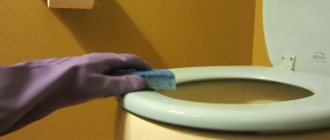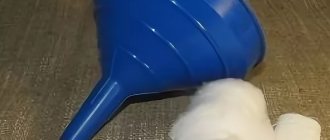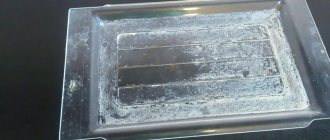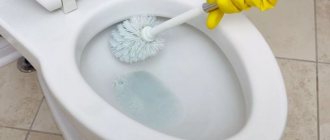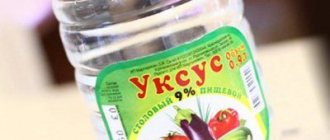A once clean sink, a sparkling white bathtub, even shiny taps and mixers eventually become covered with mineral deposits, unpleasant streaks and stains that cannot be washed off with ordinary cleaning solutions. To prevent the situation from getting worse, you need to urgently take decisive action and use stronger cleaning agents.
Even with regular cleaning of sinks, bathtubs, toilets and other plumbing fixtures, limescale deposits gradually appear on them. Water contains dissolved minerals, which do not disappear when it dries, remaining on the surface and forming deposits. These deposits are usually very resistant to conventional cleaning agents and require extensive measures to remove limescale deposits. We'll tell you how to remove limescale depending on the surface on which it formed.
Do not forget that all work with strong caustic solutions should be carried out wearing protective gloves !
Enameled sanitary surfaces
To avoid damaging the enamel, do not use metal brushes for cleaning. The best option would be a soft foam sponge or cloth.
Of course, the surest way is not to run and regularly clean the enamel bathtub and other enamel-coated plumbing fixtures. But over time, even with regular care, rust stains, waterstone deposits and other unpleasant consequences of long-term use may appear, spoiling the appearance. How to completely clean enameled plumbing fixtures and return them to their original appearance?
Acid method
Lime deposits are easily dissolved by acids. The most popular household acids are acetic and citric. We will use them.
- Lemon acid. Take at the rate of 50 g per 2 glasses of warm water. Dissolve so that no grains remain. Dampen a soft sponge in the resulting solution and wipe it over the entire surface to be cleaned. Without rinsing, repeat the procedure after 15 minutes, carefully walking through the contaminated areas. Dense lime deposits can be removed by placing a cloth or napkins soaked in the same acidic solution on top of them and leaving for 20–30 minutes. Then rinse with water. If the deposits have not completely disappeared, the procedure can be carried out again.
- Vinegar. Instead of citric acid solution, you can use 9% vinegar (not essence!). The algorithm of actions is the same as in the previous case, just be careful - do not inhale the caustic fumes. After vinegar treatment, the room should be ventilated.
Alkaline method
- Mix baking soda and soda ash in equal proportions, add a little water to form a paste. Rinse the item to be cleaned with water to keep it damp. Apply the resulting slurry, rubbing it evenly over the entire surface using a soft sponge. Leave for 20 minutes, then wipe with a sponge soaked in clean water. Rinse off.
Combined method
To achieve maximum cleansing effect, you can combine both methods. So, almost any limescale deposits, rust streaks and other contaminants from an enamel bathtub, sink and other enamel-coated products can be removed as follows:
- First we proceed as in the alkaline method. Mix baking soda and soda ash in equal proportions, add water until a thick mushy mass is formed, which is then evenly spread over the enamel surface of the product. Leave for 20 minutes.
- Without removing the slurry that was applied a step earlier, lightly rub everything with a soft sponge or rag soaked in 9% vinegar. Leave for 20 minutes.
- We wet the sponge in clean water, wipe everything with it again, rinse thoroughly and enjoy the cleanliness.
Don’t forget to work only with gloves, otherwise you can remove the skin from your hands along with the dirt.
Tips from housewives
The industrial solution “Belizna” is popular among housewives ; it effectively whitens surfaces, disinfects and does not cause significant damage to the budget.
Liquid based on sodium hypochlorite (chlorine) is not contraindicated for treating enamel surfaces in diluted form. For cast iron products the ratio of “Whiteness” and water should be 1:2, for steel - 1:3.
Chlorine copes with stains of grease, dye, and destroys bacteria, but it is less effective when removing limescale. The best use is disinfection once a year.
It is necessary to fill the bowl with water (temperature 25-30 degrees), add 2 bottles of “Whiteness”, after 15 minutes drain the water and rinse the surface thoroughly.
It is not recommended to use the product for acrylic bathtubs to avoid restoration or complete replacement of the bowl.
All the most important and useful information about cleaning the bathroom is collected in this section of the site.
Acrylic bathtubs, sinks and other acrylic products
If you are the proud owner of an acrylic bathtub or other acrylic bathroom fixtures, be careful when trying to clean your plumbing marvel. Acrylic is very sensitive to aggressive chemicals and abrasives. Therefore, we immediately sweep aside any cleaning powders and brushes with hard or metal bristles.
It is better to clean acrylic plumbing fixtures from limescale only with the help of special detergents designed specifically for cleaning acrylic surfaces . It is not advisable to use concentrated alkalis or acids; the surface can be damaged, and abrasive powders will leave scratches.
citric acid to remove limescale . For this:
- Fill the bathtub (or sink) with hot water.
- Dissolve 100 g of citric acid in a small container, for example in a glass jar (so that the powder is completely dissolved and then does not settle to the bottom), pour it into the bath, stir.
- Leave for 2-3 hours.
- We drain the water, wipe with a sponge, rinse with running water and wipe dry.
Taking into account the coating material
Different materials require an individual approach to combating limescale. Before the process you must:
- read the manufacturer's recommendations,
- carefully study the labeling and instructions on the packaging of the industrial product,
- take into account the properties of the surface when preparing a home remedy.
Acrylic
Bathtubs made of polymer materials attract buyers with their light weight, low price and variety of shapes. They are easy to clean due to the absence of pores on the surface and are less susceptible to contamination.
For regular cleaning, a soap solution and a sponge are sufficient . If the moment is missed, the bowl of the product is covered with lime deposits, it is necessary to use industrial sprays and gels with special markings (Cif Cream, Acrylan, Sun Klin) or a home solution based on citric acid or lemon juice.
To care for a bathtub made of polymer materials, only special sponges are used, for example, “Chistulya” for acrylic, enamel and earthenware.
Enameled
The enamel coating, according to GOST, has a number of features:
- resistant to alkali (sodium hypochloride, chlorine-containing bleaches, soda);
- tolerates cleaning with industrial abrasive detergents (Comet, Pemolux);
- does not allow prolonged contact with inorganic acids (contained in “Toilet Duckling” products, some types of Cillit Bang).
Prolonged contact with strong acids destroys the enamel, the surface loses its shine, color, and becomes rough.
Steel
Bathtubs are more resistant to mechanical damage, which can lead to rust, than cast iron.
They do not tolerate high temperatures well. It is unacceptable to wash a steel bowl with hot water ; this will lead to cracking of the enamel.
The choice of means for removing plaque from such a product is quite wide: from cleaning and bleaching agents to concentrated gels and solutions. Mandatory condition: in tandem with a soft foam sponge.
Cast iron
Bathtubs made of cast iron are durable, stable, not subject to corrosive processes and retain heat well.
To keep the enamel surface clean, regular detergent and a soft sponge are sufficient after each use . If plaque does form, you can use both powdered products and liquids containing chlorine, alkali and weak acids for removal.
It is necessary to avoid mechanical damage to the surface, this will accelerate the formation of stains and plaque in the future.
Stainless steel
Removing limescale from a stainless sink, bathtub or other plumbing fixtures should be done with caution, as strong reagents can leave black streaks. Therefore, we either use special means for cleaning stainless steel, or inexpensive improvised means, but with caution so as not to cause harm.
Here is a simple, cheap, safe, but effective way to clean water scale from stainless steel plumbing fixtures:
- Mix 9% table vinegar and hydrogen peroxide in a 2:1 ratio. For washing, 6 tablespoons of vinegar and 3 tablespoons of hydrogen peroxide are usually enough. A stainless steel bath will require a few more ingredients. We thoroughly spray the surface with the resulting solution from a spray bottle, do not forget about the chrome-plated parts of the mixer, and place napkins or pieces of clean cloth soaked in the same solution on areas with particularly strong limescale deposits. Leave for 20–30 minutes.
- We wipe with a sponge; we go through inaccessible or particularly dirty areas with a toothbrush. Wash off with clean water. If necessary, repeat the procedure.
- Wipe dry. To bring the final shine, wipe everything with a slice of lemon or spray it with glass cleaner, wipe it again with a dry cloth and enjoy a clean, fragrant and shiny surface.
Soda and peroxide - anti-scale mixture
Baking soda powder doused with hydrogen peroxide will corrode scale on heating elements. The product is not suitable for removing plaque from surfaces that can easily be scratched.
Ceramics: faience and porcelain sanitary ware, ceramic tiles
Waterstone can also form on ceramics. In earthenware or porcelain toilets, near faucets on sinks, around drain holes, on ceramic tiles along the bathtub, and so on - wherever tap water gets in.
How to remove limescale from a ceramic surface? Citric acid is perfect for this .
- Prepare a saturated solution: pour 100 g of citric acid in powder form into 200 ml of warm water, stir thoroughly so that no crystals remain.
- Pour the prepared solution into a spray bottle.
- generously onto the ceramic surface. For greater effectiveness, rub with a sponge as you spray. We don’t save the solution. Then wait 15–20 minutes.
- Wipe again with a wet sponge, then rinse everything off with water and wipe dry.
- If there is plaque left somewhere, place napkins or pieces of cloth soaked in the prepared solution on such difficult areas. Do not touch for half an hour, remove the applied cloth or napkins, clean off the softened plaque with a toothbrush, then rinse everything off with water and wipe dry.
The method is quite effective, safe, cheap and accessible to everyone. Instead of a citric acid solution, the surface can be wetted with 9% food vinegar, apply pieces of cloth soaked in the same vinegar to particularly dirty areas on the ceramic, wait half an hour and wipe with a sponge. Then wash it off. However, vinegar will produce strong fumes; citric acid does not have this problem, and the effect is no worse.
Prevention
You won’t be able to forget about limescale in your bathroom forever, but you can reduce its formation to a minimum. There are a number of preventive measures that can be taken:
- Wipe the bathtub dry after use. Get microfiber cloths. They absorb moisture well and clean surfaces without chemicals. You need to wipe everything with a napkin: faucets, mirrors, shower glass, bathtub (tray), tiles.
- Clean limescale while it is soft. If plaque is not removed in time, it will turn into scale. The scale, in turn, is converted into limestone. This problem is much more serious and may require drastic measures.
- Install a water softener filter in the tap. There are different designs: mechanical, carbon, electromagnetic, ion exchange and reverse osmosis. They cost a lot, but they work effectively. If plaque appears on plumbing fixtures, it is very soft and easily removed. The filter also helps prevent the formation of scale in a washing machine, boiler, and kettle. Soft water is also good for skin and hair.
- Use products that form a water-repellent film on surfaces. Many window cleaning sprays have these properties. They can be sprayed on bathroom tiles, mirrors and glass. Drops of moisture will drain without stopping. As a result, surfaces will remain clean longer.
Chrome or nickel plated parts of taps, mixers, aerators, sprayers
No coarse or abrasive products, no metal brushes - all this can irreversibly damage the decorative coating and it will not be possible to restore it later.
To remove limescale from the holes in the shower head , it should be disassembled. Soak parts with nozzles in heated 9% vinegar for 30–60 minutes. Then rinse with water and, if necessary, brush with a toothbrush. Assemble the watering can and attach it back to the hose. If you can’t disassemble it, then soak the entire tip of the watering can.
The same thing applies to the aerator (the nozzle on the faucet spout). It should be removed - it unscrews easily.
Then rinse in running water, soak in heated 9% vinegar for 30–60 minutes, rinse again in water, if necessary, clean off the softened plaque with a toothbrush and screw it back on.
When soaking plumbing parts in vinegar, do not forget to cover the container with cellophane to minimize evaporation.
We clean the chrome or nickel plated parts of the faucet from water stone.
- Lemon. If the contamination is not too serious, you can get by with regular lemon: rub the parts of the mixer with a slice of lemon. Leave for 20-30 minutes, then rinse with a sponge soaked in water and wipe dry.
- Vinegar. More serious lime deposits can be removed with vinegar. Moisten the parts with 9% table vinegar. Wrap the most contaminated areas with pieces of cloth or napkins soaked in vinegar. Wait about half an hour, rinse, clean hard-to-reach areas with a toothbrush, and wipe dry.
For final cleaning of nickel and chrome plated surfaces, removing dark spots or stains, toothpaste is excellent. Apply a small amount to the cotton wool and rub thoroughly until shiny. Remove any remaining paste with cotton wool or a dry cloth and enjoy the cleanliness!
Rating of anti-limescale products
Manufacturers of household products offer a variety of gels and powders that prevent the appearance of crusts. But not all of them are safe for coating and human health. The editors of the publication VyborExpert.ru talked with manufacturers of bathroom and kitchen accessories, plumbers and housewives to compile a review of useful products. The following selection criteria were taken:
- Application area;
- Compound;
- Exposure time;
- Consistency;
- Price.
Glass
Experience shows that cleaning glass surfaces is not difficult. Ordinary laundry soap will help deal with simple stains, and if anything remains, it can be easily removed with a solution of citric or acetic acid. Glass is very resistant to acids, and therefore you can use them in significant concentrations , mercilessly dissolving any deposits. The final shine and cleanliness of glass surfaces will be given by a glass cleaner with a spray bottle.
Which brand of bath cleaning products is best to choose?
Brands of cleaning products become popular not only due to advertising campaigns. Gels, foams, liquids, powders included in the TOP received excellent customer ratings. According to reviews, the best bath cleaners are produced by:
- Clean Home - Russia;
- Sanfor - Russia;
- Luxus Professional - Germany;
- Sano Jet - Israel;
- Nordland - Italy;
- Comet - Germany;
- Meine Liebe - Germany;
- Sarma - Russia;
- Amway - USA;
- Homestar - Japan;
- Synergetic - Russia;
- B&B Unicum Bami – Israel;
- Bagi Akrilan - Israel;
- Pemolux - Russia;
- L'Arbre Vert - France;
- Mellerud - Germany;
- Pip - Belgium;
- Cobra The Cleaner - Germany.
Plastic
Lime deposits can form on plastic, like on any other surface. This is especially true for plastic pallets. How to effectively clean plastic?
To avoid scratching a soft plastic product, you should not rub it with hard (especially metal) brushes and abrasives. A delicate approach is required. And ordinary vinegar will help us again.
We take 9% table vinegar. Apply to plastic using a soft sponge or spray bottle. As usual, we apply pieces of cloth or napkins soaked in vinegar to particularly contaminated areas. You can pour vinegar into a plastic tray; the tray is usually not very deep, and vinegar is inexpensive - so we pour it to the brim and cover it with cellophane (so it doesn’t stink so much). Leave for about 20 minutes. And a soft sponge or napkin, carefully wipe off the softened plaque (if it has not completely dissolved by this time). Rinse with clean water and wipe dry. Instead of table vinegar, you can use a solution of citric acid - 25 g of acid per 1 glass of water.
If you know how to clean any surface from limescale and are not lazy, your plumbing will always delight you and your family with its cleanliness and beautiful appearance.
How to remove with special compounds?
It is easier to choose ready-made concentrates and solutions of household chemicals, since the manufacturer indicates on the label for the surfaces what material they are made of. Housewives recommend:
Bagi Acrilan is a universal spray foam for baths made of any materials based on surfactants and citric acid.
Effectively fights lime deposits and pollution of any degree and nature. Simply apply to the surface and rinse with water. No additional sponging is required. Price for 400 ml – 400 rubles.- Clean Home is a bathroom cleaning gel based on anionic surfactants, suitable for all surfaces. Removes lime deposits, rust, unpleasant odors, disinfects. Does not cause allergic reactions. Price for 800 ml – 200 rubles.
- HG – concentrate for baths and toilets, effectively removes plaque and rust in a few minutes. Can be used on any surfactant-based surfaces. Price for 500 ml – 450 rubles.
Causes of the problem
Enamel coating is a crushed substance that is applied to a cast iron bath using the electrostatic method. After processing at high temperature in a heat chamber, the composition is “baked.” The result is a very smooth, glossy and strong surface.
Without proper care, the enamel coating of a cast iron bathtub loses its original attractiveness and shine. Among the culprits, there are 3 types of pollution:
- Limescale. Mineral inclusions in hard water leave a thin coating on the walls of plumbing fixtures. A barely noticeable, whitish layer accumulates, growing into strong, extensive areas.
- Rust. A high concentration of iron in tap liquid appears in the form of untidy yellowish spots on the enameled surface of a cast iron bathtub. Occurs when a leaking faucet or regular storage of water in a plumbing bowl.
- Fat layer. Small particles of sweat, human skin and soap residues during bathing settle on the coating. As they accumulate, multiple deposits form a permanent stain.
What not to use
Manufacturers of household chemicals offer customers products with a balanced composition. They are responsible for quality and honestly warn about risks. But there are housewives who prefer to use improvised means to clean the bathtub. At best, they do not give the desired result. At worst, the bathtub coating suffers, microcracks appear, and service life is reduced.
For cleaning it is not recommended to use:
- washing powders;
- cleaning pastes containing abrasive particles;
- chlorine;
- gasoline and acetone;
- alcohol emulsions.
Chlorine-containing products are strictly prohibited for cleaning acrylic bathtubs. Enamel is afraid of bleaches and abrasives. They cause scratches and defects to appear on the surface.



